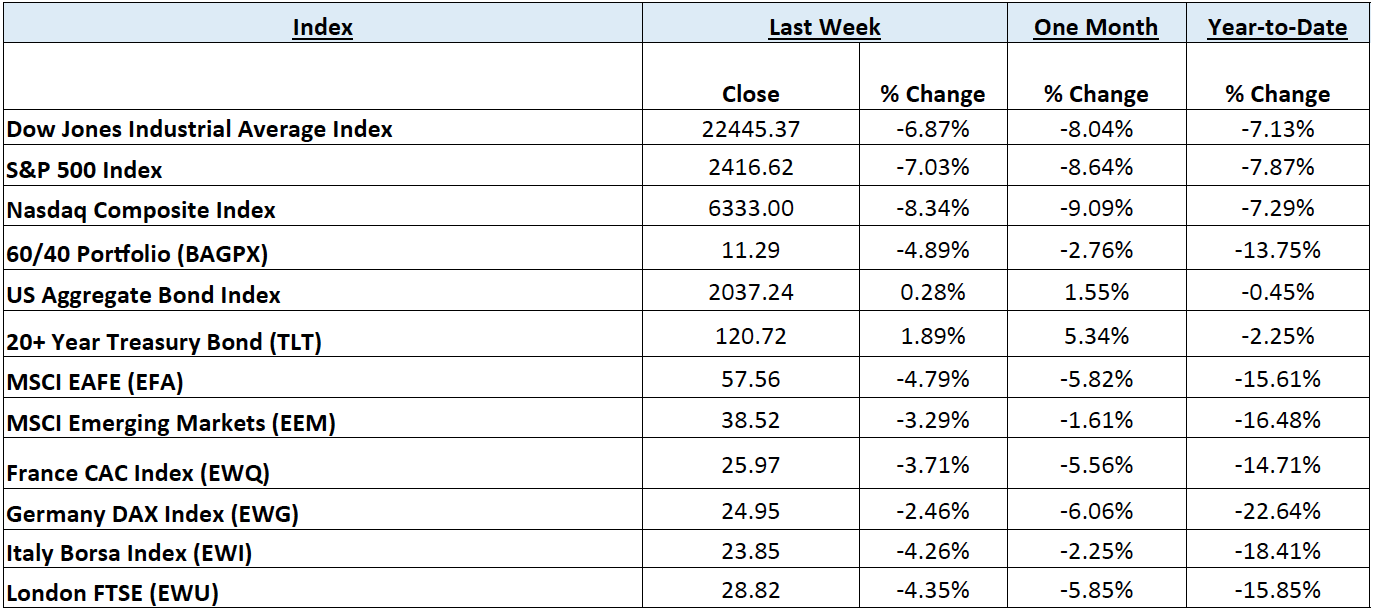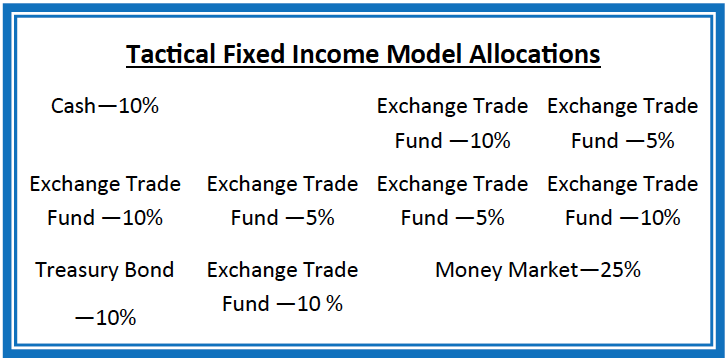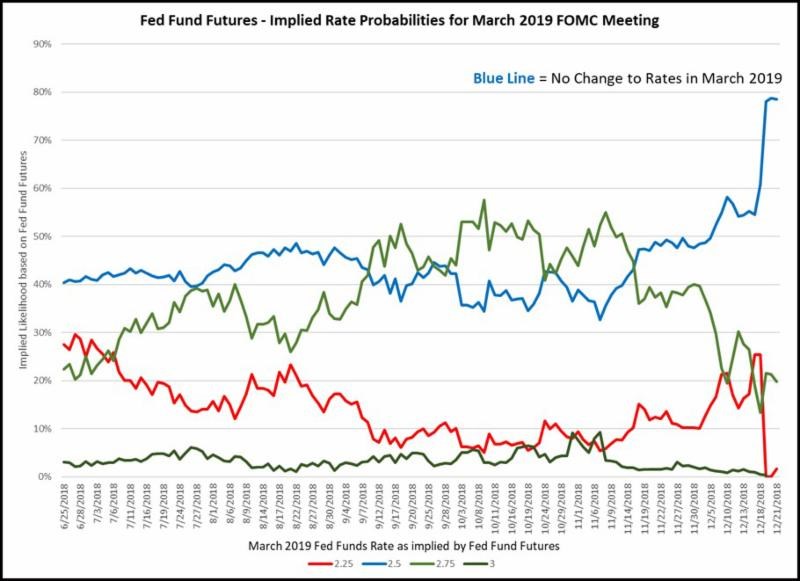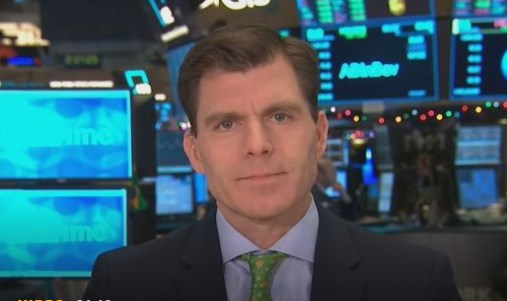HORTER INVESTMENT MANAGEMENT, LLC
Weekly Commentary horterinvestment.com December 24, 2018
The Dow just finished its worst week since the financial crisis. Four experts weigh in on the fallout
Wall Street bears are on the prowl.
The Dow Jones Industrial Average and the Nasdaq Composite just closed out their worst week since the financial crisis, while the S&P 500 closed the book on its worst week in eight years. The sell-off pushed the Nasdaq into bear market territory as fears of a government shutdown added to the pain already being felt by the markets as a result of the Federal Reserve’s decision to raise interest rates on Wednesday.
Four experts weigh in on the whipsaw action:
· Neuberger Berman’s Erik Berman says that even though his firm is heading towards overweight global equities early in 2019, there are reasons to be cautious. “There’s so much technically driven and sentiment-driven selling going on right now, and lack of liquidity, that we very much want to be cautious between now and the end of the year,” says the multi-asset CIO. On the whole, though, Berman thinks the market is pricing in too much fear in the new year. “In emerging markets and some of the other areas overseas have kind of caught up to the U.S. on the currency and debt side, so we’re now including the U.S. as being part of the opportunity set, because we really think markets have gone too far in re-rating global growth and reassessing global liquidity.”
· Bank of the West chief economist Scott Anderson echoes that sentiment: “We think the U.S. economy is performing better than the stock market right now, and we agree with the argument that you don’t go from 60 to zero overnight. We’re decelerating, the data is softening, but we’re not falling off a cliff.”
Two more rate hikes could spark a recession, market researcher James Bianco warns
He’s been worried the Federal Reserve would go too far.
And now, market researcher James Bianco thinks his fear may be a reality.
His updated outlook follows the Fed’s decision to plan for additional interest rate hikes next year. Bianco believes the move could spark a recession.
“The markets are worried that two rate hikes next year may be too many,” the Bianco Research president said Wednesday on CNBC’s “Trading Nation. ”
According to Bianco, the Fed’s latest statement is just the prescription to frighten the market over a monetary error — adding that the leading cause of a recession is Fed policy that’s too tight.
He’s also concerned the balance sheet reduction plans in 2019 could create serious headwinds
“It was not dovish enough for the market,” he said about the Fed’s statement.

Taking a comprehensive look at the overall current stock market
Taking a comprehensive look at the overall current stock market, you can see the chart below representing eight major indices and their returns through the week ending December 21, 2018. In a truly diversified portfolio, the portfolio’s total return is determined by the performance of all of the individual positions in combination – not individually.
So, understanding the combined overall performance of the indices below, simply average the 12 indices to get a better overall picture of the market. The combined average of all 12 indices is -11.87% year to date.

Data Source: Investors FastTrack, Yahoo Finance, Investopedia

Past performance is not a guarantee of future results. This Update is limited to the dissemination of general information pertaining to its investment advisory services and is not suitable for everyone. The information contained herein should not be construed as personalized investment advice. There is no guarantee that the views and opinions expressed in this newsletter will come to pass. Investing in the stock and bond markets involves gains and losses and may not be suitable for all investors. Information presented herein is subject to change without notice. Horter has experienced periods of underperformance in the past and may also in the future. The returns represented herein are total return inclusive of reinvesting all interest and dividends.
The above equity, bond and cash weightings are targets and may not be the exact current weightings in any particular client account. Specifically, there may be cases where accounts hold higher cash levels than stated in these target weightings. This is usually to accommodate account level activity. Furthermore, some variable annuity and variable universal life accounts may not be able to purchase the exact weightings that we are indicating above due to specific product restrictions, limitations, riders, etc. Please refer to your client accounts for more specifics or call your Horter Investment Management, LLC at (513) 984-9933.
Investment advisory services offered through Horter Investment Management, LLC, a SEC-Registered Investment Advisor. Horter Investment Management does not provide legal or tax advice. Investment Advisor Representatives of Horter Investment Management may only conduct business with residents of the states and jurisdictions in which they are properly registered or exempt from registration requirements. Insurance and annuity products are sold separately through Horter Financial Strategies, LLC. Securities transactions for Horter Investment Management clients are placed through TCA by E*TRADE, TD Ameritrade and Nationwide Advisory Solutions.
For additional information about Horter Investment Management, LLC, including fees and services, send for our disclosure statement as set forth on Form ADV from Horter Investment Management, LLC using the contact information herein. Please read the disclosure statement carefully before you invest or send money.
Dow Jones – Week Ending
WEEKLY MARKET SUMMARY
Global Equities: Dip-buyers disappeared as US stocks closed out their worst week since 2011 on the heels of the highly anticipated Federal Reserve (Fed) decision. Lowered expectations for the future path of the Federal Funds rate apparently weren’t enough to swing the pessimism surrounding global growth, Brexit, the trade war, and now a government shutdown. All three major US equity indices were battered, with the Nasdaq Composite leading to the downside, losing over -8.3% on the week. The Dow Jones Industrial Average and the S&P 500 lost around -7% each. None of the S&P sectors were spared, but the Energy sector was particularly bruised, as its Select Sector Energy SPDR ETF (XLE) lost over -9.5% on the week. International equities continue to show relative strength after having been already beaten down this year, as International Developed equities and the iShares MSCI EAFE Index ETF (EFA) lost -3.8%, while Emerging Market equities represented by the iShares MSCI Emerging Market Index ETF (EEM) fell nearly -1.9% on the week.
Fixed Income: Treasury yields fell steadily as the safe-haven trade continued and the yield on the 10-year US Treasury Bond finished just off the low of the week, near 2.78%. Credit is being shunned by investors as outflows from high yield bond funds have continued to be reported by Lipper. High yield bond spreads over equivalent Treasury securities have widened to over 5% for the first time since 2016 as falling oil prices threaten the cash flow of US energy companies, who are not insignificant constituents of high yield borrowers.
Commodities: Oil prices extended their slide during the week while OPEC members scramble to ease concerns regarding excess supply. It has not been easy to battle emboldened bearish speculators, but it will be necessary as oil producing companies and countries most-likely have budgeted with assumptions of much higher prices. The American West Texas Intermediate (WTI) and the International Brent crude benchmarks finished the week down over -11%, near $45 and $53 per barrel, respectively. Natural gas prices slipped another -2%, closing near $3.70/MMBtu.
WEEKLY ECONOMIC SUMMARY
FOMC Announcement: The Federal Reserve Open Market Committee (FOMC) delivered on an expected .25% hike to the benchmark Federal Funds rate while also shifting its tone to a less restrictive monetary policy by only forecasting two additional rate hikes in 2019. This “dovish” rate increase to a target range of 2.25-2.5% was widely expected as softening economic data and moderating inflation expectations necessitate a more delicate approach to increasing the Federal Funds rate, which Chairman Powell himself says is near the neutral rate that neither accelerates or limits economic growth. The FOMC statement did not assuage equity market volatility, however, as they walk the tightrope of being overly restrictive and risk derailing economic growth or being overly accommodative and appearing to succumb to political pressure.
Gross Domestic Product (GDP): The third and final estimate for 3rd quarter (Q3) US GDP was released on Friday and was revised slightly downward from the prior estimates from an annualized quarter-on-quarter (QoQ) growth rate of 3.5% to 3.4%. An incremental increase from rising inventories was not enough to offset lower revisions to net trade and consumer spending during the period. This growth rate is widely expected to be the high-water mark for this economic cycle as US economic growth mean-reverts from its likely-unsustainable path as tailwinds from easy monetary policy and tax cuts fade.
Personal Income & Outlays: Consumer spending reportedly rose at a higher than expected .4% month-on-month (MoM) increase for November, according to the Bureau of Economic Analysis (BEA). Personal income increased by only .2% for the same period, which was slightly below the consensus estimate of .3%. Personal Consumption Expenditures (PCE), a measure of inflation, came in at the low end of the consensus range at 1.8% year-on-year (YoY) thanks to lower oil prices that have continued to fall. Core PCE, the favorite measure of inflation for the Federal Reserve (Fed) which excludes food & energy, was in line with the consensus estimate and just below the Fed’s target, at 1.9% YoY.
Current Model Allocations


Summary
In utilizing an approach that seeks to limit volatility, it is important to keep perspective of the activity in multiple asset classes. We seek to achieve superior risk-adjusted returns over a full market cycle to a traditional 60% equities / 40% bonds asset allocation. We do this by implementing global mandates of several tactical managers within different risk buckets. For those investors who are unwilling to stomach anything more than minimal downside risk, our goal is to provide a satisfying return over a full market cycle compared to the Barclays Aggregate Bond Index. At Horter Investment Management we realize how confusing the financial markets can be. It is important to keep our clients up to date on what it all means, especially with how it relates to our private wealth managers and their models. We are now in year nine of the most recent bull market, one of
the longest bull markets in U.S. history. At this late stage of the market cycle, it is extremely common for hedged managers to underperform, as they are seeking to limit risk. While none of us know when a market correction will come, even though the movement and volatility sure are starting to act like a correction, our managers have been hired based on our belief that they can accomplish a satisfying return over a full market cycle, – while limiting risk in comparison to a traditional asset allocation approach. At Horter we continue to monitor all of the markets and how our managers are actively managing their portfolios. We remind you there are opportunities to consider with all of our managers. Hopefully this recent market commentary is helpful and thanks for your continued trust and loyalty.







